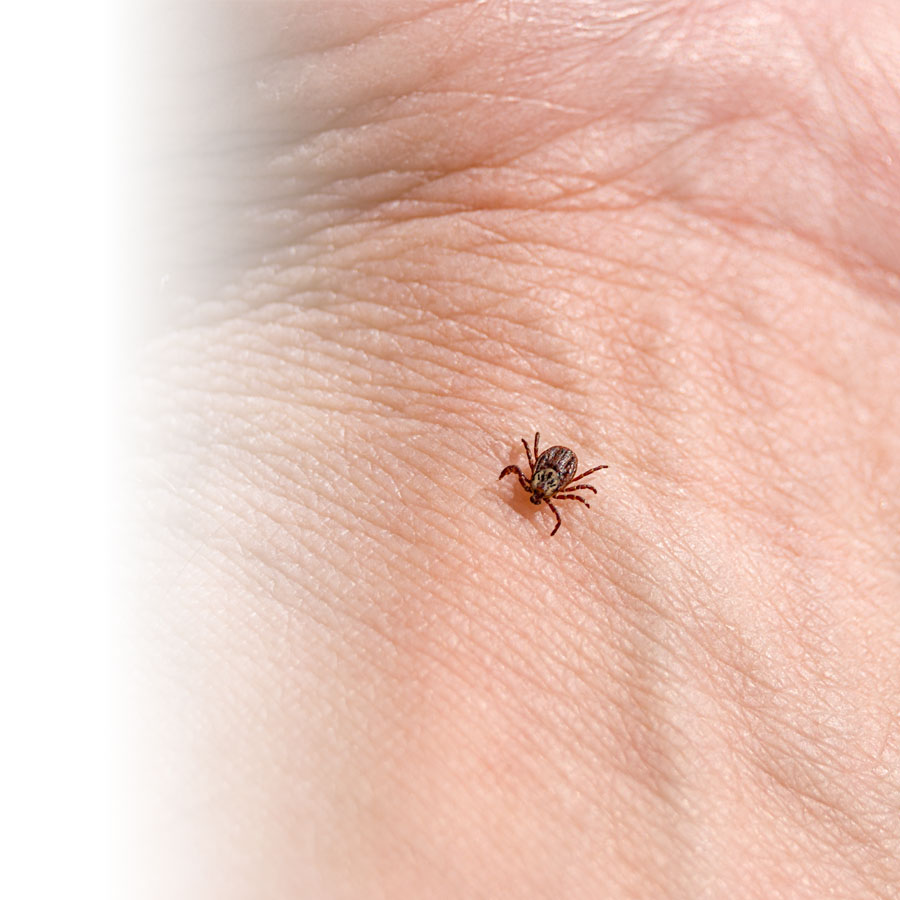Lyme disease, a tick-borne infection, has caused a lot of ink to flow in recent years. Here is some information about it.
Causes and transmission
Lyme disease is an infectious disease caused by a bacterium called Borrelia burgdorferi. It is transmitted to humans through the bite of certain types of ticks. In order to transmit the disease, ticks must be infected by the bacterium in question. These vampire-like insects feast on the blood of humans and certain animals.
To have time to transmit the infection, ticks must remain latched on to a host for at least 12 to 24 hours. The longer the tick latches on, the greater the risk of contamination. Since their bite is usually painless, it often goes unnoticed. The infection is not transmitted from human to human or from other insects or animals to humans.
Risk factors
Anyone, regardless of age or background, can be affected by Lyme disease. People who work or practise outdoor activities, (landscapers, farmers, forest rangers, hikers, hunters, campers, etc.) are particularly at risk—even more so if they venture off the beaten path.
The risk of tick bites is present from spring through early winter, peaking in spring and summer.
Signs and symptoms
Following a tick bite, the bacteria spread through the skin and then into the blood, and to certain tissue. The signs and symptoms can be numerous and depend on the stage of the disease. They usually appear between 3 and 30 days after a bite from a tick carrying the bacteria. They may include, for example:
- a red bull's-eye pattern around the tick bite
- fatigue
- weakness
- spasms
- fever
- shivering, and
- muscle soreness
In advanced stages, the disease can cause damage to the joints, heart and nervous system. In the most severe cases, death can occur.
Treatment
Lyme disease can be treated, especially if it is detected early. In any event, it can be difficult to recognize, since its manifestations resemble those of many other diseases. Prompt medical attention can prevent the condition from worsening. Treatment is based on antibiotic therapy.
If you must take an antibiotic to treat Lyme disease, your pharmacist will inform you of the dosage, duration of treatment, possible side effects and interactions, and the precautions to be taken.
Some advice to prevent tick bites
- Wear long clothes with maximum coverage, ideally pale in colour. This will help you spot ticks.
- Wear socks (ideally pulled up over the pant leg) and closed-toed shoes or boots.
- Learn to recognize the types of ticks that are most often infected with the bacteria.
- Check with local public health offices to see if the area you live in or visit is at risk.
- Use DEET-based insect repellents when you spend time outdoors, especially in high-risk areas.
- Try to avoid contact with small shrubs and long grass when walking in the woods, fields or other areas where this type of vegetation grows. For example, walk in the centre of trails.
- After an outdoor activity, take a shower to get rid of any ticks that may not yet have latched on to the skin.
If you ever notice that a tick has latched on to your skin, do not kill it by crushing it. Instead, follow these steps:
- Be sure to remove the tick as soon as possible—ideally within 24 to 36 hours to avoid infection.
- Using clean tweezers, grasp the head of the tick as close to the bite point as possible, then pull gently vertically upward.
- Clean the bite with soap and water.
- Place the tick in a bag or an airtight container, such as a clean, empty pill bottle. If it is alive, you can store it up to 10 days in the refrigerator. If it is dead, place it in the freezer.
- Make a note of where and when the bite occurred.
- If you develop symptoms of infection in the next few weeks, take the tick to your doctor for testing.
Pharmacists can now prescribe a preventive treatment against Lyme disease for people who have been bitten by a tick. If you are in a high-risk area and believe you have been bitten, go to the pharmacy as soon as possible for a consultation with the pharmacist. You should take the insect with you in an airtight container to show them. The pharmacist will make a thorough assessment of the situation to decide whether or not to prescribe an antibiotic.
For information about insect repellent, which is recommended to prevent tick bites, read the following text: Protection against insect bites using five questions.
Speak to your pharmacist to find out more about Lyme disease, protection against insects, and other ways to stay healthy during summer.

